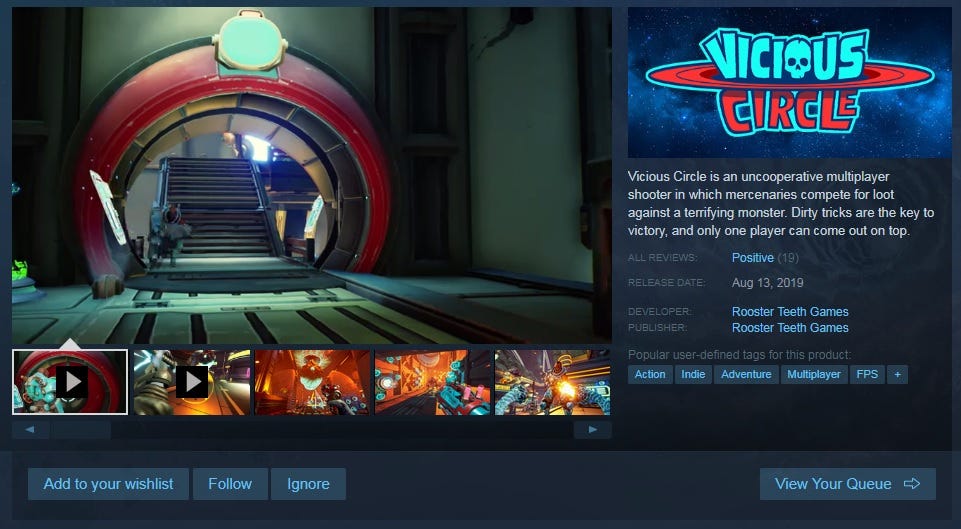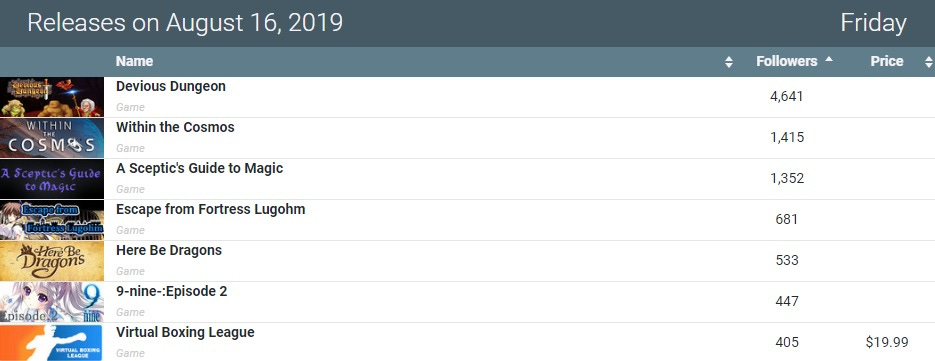
Featured Blog | This community-written post highlights the best of what the game industry has to offer. Read more like it on the Game Developer Blogs.
In the interests of focusing on one particular part of game discoverability, I’d like to concentrate this piece on one particular hidden gem of a statistic - Steam’s follower count.

In the interests of focusing on one particular part of game discoverability, I’d like to concentrate this piece on one particular hidden gem of a statistic - Steam’s follower count.
Most people making games for Steam are aware of - and closely monitor - their game’s wishlists. As discussed in my first newsletter / column, your wishlists at your game’s launch are a key indicator of how it might sell.
(In addition, the amount of wishlists your game accumulates after launch are a key indicator of its long-term popularity. This is particularly because Steam users may get emailed about your game if it’s on sale and they have wishlisted it.)
Anyhow, wishlists are golden - but they are also private. Only people with access to the Steam back end for their particular game can see them. However, a statistic that is public is the ‘Steam follower count’. (You have less followers than wishlists, by the way - wishlists are around 4.5x follower counts.)
On each game’s Steam page is the ability to ‘Follow’ a title to see announcements about it in your Steam Community Activity Feed. It’s right next to ‘Add to your wishlist’ (see below pic from Steam website!), and is basically a light expression of interest:

Excitingly, if you go to the Steam Community Groups search page and look for the name of a particular game, you can see how many followers the group attached to a game has, before you click on it. (There’s probably a better way to do this, that’s just how I do it.)
This follower count - as the wishlist count - changes drastically (upwards!) after launch. But if you’re checking very close to a Steam launch, here’s a basic rule of thumb from the ever helpful Jake Birkett: "Basically followers x 2.5 = week 1 sales. But of course it can vary quite a lot for different games, and probably for different reasons."
(Side note: read the rest of Jake’s excellent post on the economics of making indie games, if you didn’t. It goes further than my earlier posts into the complexities of making money in this space.)
Anyhow, back to exemplifying. Let’s take Within The Cosmos, which has 1,600 Steam followers and is launching on Friday, August 16th. Perhaps it adds a few more followers by its launch hour.
Even so, via Jake’s basic formula this implies it should sell just over 4,000 copies in its first week - and perhaps 20,000-25,000 copies in the first year, but not all of those at full price. Not bad! Not bad? (Depends on how much it cost, if there’s other platforms, etc.)
Is this completely accurate, I see you scoff? Absolutely not. It may be off by a factor of 2 or 3, even. But it’s unlikely to be off by a factor of 10 or 100.
So if you’re seeing a game about to launch with 10 followers - it’s really likely to be a flop in commercial terms. And if you’re seeing an upcoming title with 20,000 followers - it’s going to be at least a medium-sized hit. (BTW, Cyberpunk 2077 has 430,000 followers already - you may want to buy stock in CD Projekt now.) Anyhow, the same essential truths for wishlists extend to followers.
Until recently, it was kinda rough to find follower counts all in one place. You just had to look them up manually, or there was a custom spreadsheet or two created for Ryan Clark of Clark Tank (& Crypt Of The Necrodancer/Cadence Of Hyrule!) fame.
But now, as pointed out by Lars Doucet:
SteamDB (pictured) now has a graph of follower counts for games released on that day and each upcoming day - sorted by day. (Remember that follower counts will start going up majorly as soon as the game is released & it gets extra exposure.)
SteamHype has follower counts for all upcoming games, which are filterable for all kinds of genre, pricing, and other info.

These tools both seem invaluable in terms of understanding what PC games are about to be popular in today’s market.
Though a lot of games hang out without a clear release date - until they get dated, and you can’t mess with that any more - you can at least get a general idea of the popularity of games coming out in the next few weeks - and you can search for the ones without a clear release date.
Finally - listen, I know a lot of this seems like the tedious Sabermetrics-ization of video game development and publishing. And none of this is a guarantee that your game is or isn’t going to be a hit.
But I think it’s very reasonable to look at the kind of titles that have more than 1,000 followers at launch (a number that everyone should aspire to, I think!) and ask - what made them special?
What traits did they have, how much might they have cost to create - financially and creatively - and why were people excited to push that ‘Follow’ button?
A few hours doing this, away from actually making your game, may pay dividends in the future if you’re an indie dev.
Or if you don’t want to do that, pay a publisher to think about it, and tell you what to change or adapt, I guess. But you’d better be sure that they understand these dynamics properly, otherwise your hard-won revenue share may be wasted.
(Yes, ‘should you get a publisher?’ is another of the near-infinite topics that we’ll tackle at some point in this blog series! And my answer, just to telegraph it, is ‘maybe’. But look forward to another 1500 words on it soon.)
[This article was originally published as part of the Game Discoverability Weekly newsletter, which you can subscribe to now.]
Read more about:
Featured BlogsAbout the Author(s)
You May Also Like








